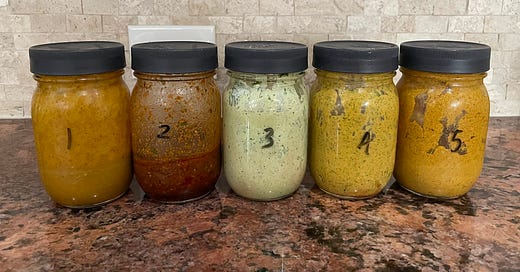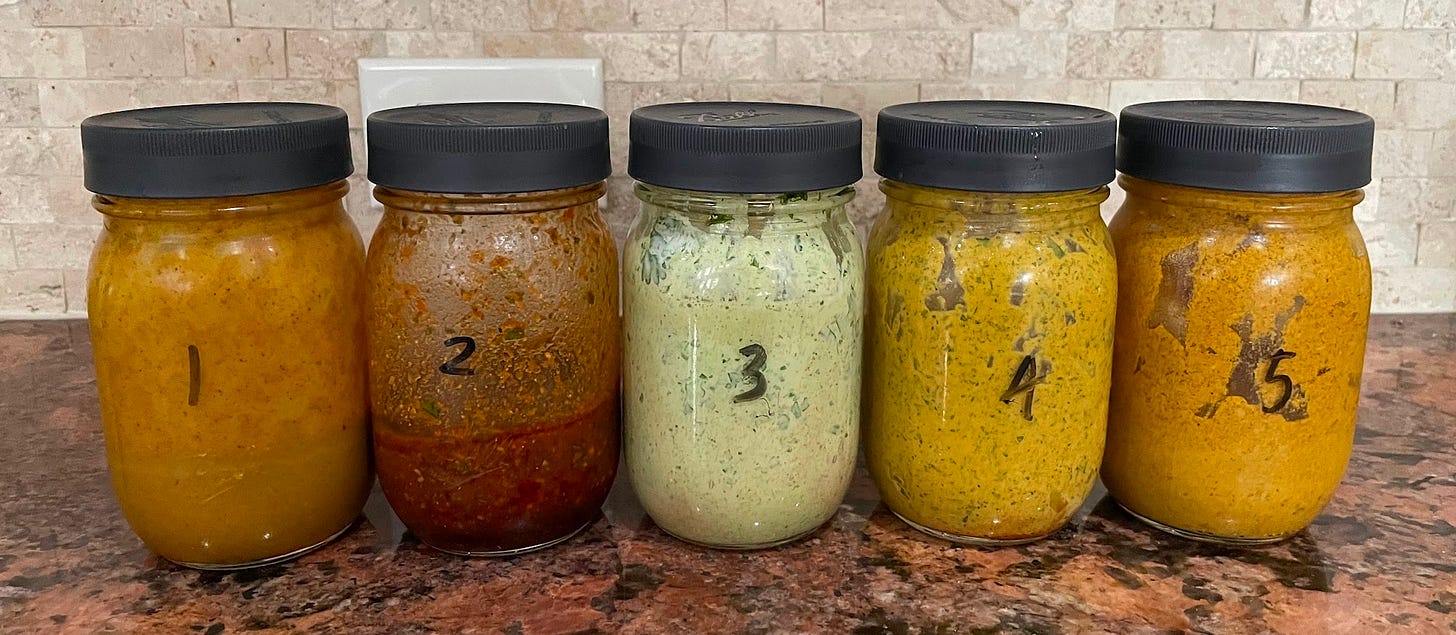I Turned Moribyan's 5 Chicken Marinades Into An Excel Sheet
Where chemistry and consulting meat, just in time for Ramadan
I spent the summer days after my freshman year of college in a chemistry lab, using recycled solvents to make molecular baskets (calixarenes, specifically; calix[5]arenes, even more specifically). A decade later, I joined a management consulting firm and spent the first few months building an Excel model for a post-merger integration.
These two jobs aren’t really related to psychiatry, but it turns out that they proved invaluable to household management, because the translatable skills I learned were:
Tolerating dishwashing (so many flasks!)
Getting all my ingredients out before starting to cook (once that reaction was going, there was no time to waste—just like the garlic/ginger will start to burn if you haven’t already gotten out your tomatoes)
How to use Excel to make everything from birthday parties to income taxes a little bit easier
Part of my job now involves making clinical workflows more efficient, and as my husband can attest to, I am all about process improvement at home, too.
Yet as much as I’d like to be a lean, efficient machine in the kitchen, two kids in two years derailed me. I have not at all gotten into a routine with meal prep and planning; the cognitive burden of figuring out what to make, when to make it, and whether we have all the ingredients for it can be overwhelming. With Ramadan on the horizon, I needed a solution—especially with a four-person household and way less time.
So when my friend shared Moribyan’s 5 Chicken Marinades recipe with me, I was ecstatic—I only wish I had come across it sooner; it would have saved me in those early newborn days, and I think it may be the key to weeknight meals going forward even after Ramadan. As I looked through the 5 recipes, I thought: how can I make making these marinades as efficient of an operation as possible?
Going back to chemistry lab and consulting, here was the approach:
Fewest amount of dishes
Grouped ingredients, ready to go
An Excel sheet
I set up 5 mason jars (plus a blender jar), and the only measures I really needed were 1 tsp, 1 tbsp, and 1/2 cup (the smaller measures can be estimated from those). I then sorted out the condiments, the produce, and the dry spices (and added in that order). Shook it all up, and done.
Where the Excel comes in handy is that instead of making each marinade separately, you can work by ingredient: add cumin in jars 2-5; coriander in 1,2, and 5; turmeric in 1, 4, and 5, etc.). It sounds minor, but the reduction in cognitive effort is significant: instead of your brain switching to “select coriander jar and measure it out” three distinct times, you only do it once.
Additionally, if you wanted to make just one marinade (but why would you want to, they all look delectable), you can filter out the “-”s so you only see the ingredient for that one.
So there you have it, 10 lbs of chicken with various flavor profiles, courtesy of Moribyan, shared with me by my friend, and streamlined for maximum operational efficiency and minimum cognitive burden, for you.
Web link (won’t have filters): Moribyan's 5 Chicken Marinade Excel Web Page
Downloadable file: Moribyan's 5 Chicken Marinade Excel Sheet.xlsx
Note: You can make the marinades and freeze them separately in the jars, but if you decide to mix them with fresh chicken and then freeze it, the most efficient method is:
Chop up all 10 lb of chicken (and move into a big bowl as you go to make space on your cutting board)
Scoop the chicken evenly into five gallon-size bags with a big spoon or tongs
Add the marinades into each bag and mix it, seal it, label it, and freeze it flat
If you do it this way, you will only handle the raw meat once and you won’t run out of meat for the last marinade.
And potential subs to make things even easier:
If you don’t have yellow curry powder on hand, you can substitute for a 2:1:1 ratio of turmeric, cumin, coriander (1/2, 1/4, 1/4 tsp for 1 tsp of yellow curry powder + some extra ginger).
Lemon and lime aren’t exactly interchangeable but if you only have one or the other, just substitute.
I happened to have smoked paprika and regular paprika, and they’re not the same, but you can substitute in a pinch or use 1/3 tsp cayenne pepper for every 1 tsp paprika.
I don’t use onion powder and just used chopped onions (less than 1/4 cup).
Leftover coconut milk is super versatile; you can make a yellow curry with that same powder + chicken and other vegetables, or mix it up with chia seeds, vanilla, and maple syrup and have it as a pudding.







Can I just say this is the answer to my Dua lol.. from one woman who loves excel to another, you have provided such helpful advice.
When I married my husband his family owned 1 Indian restaurant. Gotta admit, I love Indian food. But when they sold the restaurants, and I suddenly had to make dinner every night, I cried into my aloo ghosht. It’s been a learning curve and I’m at the bottom of the curve.
May God bless you 😘😘 I will try these…
Omg, you're a genius! This is so useful, thank you